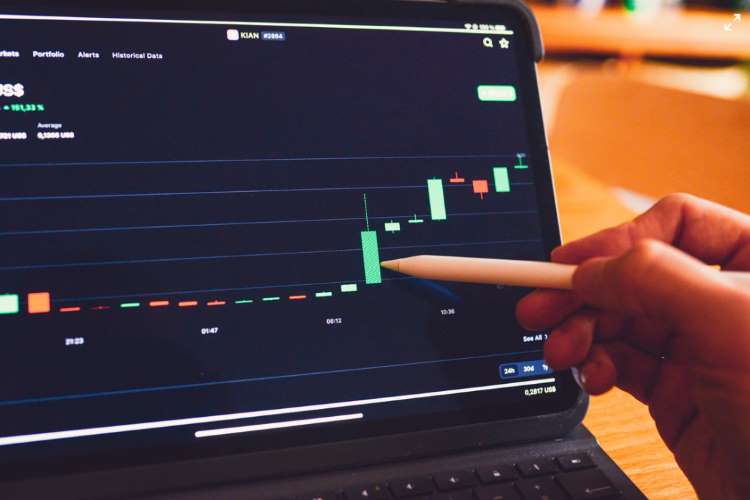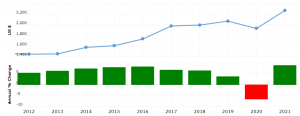
Indian economy: The Federal Reserve is again expected to hike its key interest rate by three-quarters of a percentage point on Wednesday to battle high inflation, signalling a looming global recession. The signs of an economic slowdown have begun to register with policymakers and the trickle down effect of the ongoing war between Russia and Ukraine will not spare India as well.
On Tuesday, the International Monetary Fund (IMF) slashed India’s economic outlook for the current fiscal as well to 7.4%. This is a further downward revision of 0.8% by previous estimates of 8.2%. However, it is still higher than RBI’s own latest estimates which put the growth projection at 7.2%. According to the IMF report, the downgrades in growth projections of three major countries are driving a negative global outlook. These countries include India, along with China and the United States.
A sharper slowdown in China due to extended lockdowns, tightening global financial conditions associated with expectations of steeper interest rate hikes by major central banks to ease inflation pressure, and spillovers from the war in Ukraine have led to a slower growth. RBI too in its recent bulletin had acknowledged the effects of war on the country’s economy and said that the nation is facing spillovers from the Ukraine-Russia war.
What’s dampening Indian economy’s growth?
For India, the revision reflects mainly less favourable external conditions and more rapid policy tightening. Elsewhere, growth revisions in the baseline have been mostly on the upside, the report said. While the Indian economy cannot evade a global recession, it is expected that tight monetary policies across the globe can help in evading a deeper recession. Meanwhile, the country is also battling with its own issues at home- a likelihood of FMCG slowdown, pressures of inflation, a boom of Chinese products, rising trade deficit and falling rupee against the US dollar.

However, the central bank and several consulting firms including Deloitte are hopeful of India’s resilience. Former Niti Aayog Vice-Chairman Arvind Panagariya also recently expressed his optimism on the prospects of the Indian economy.
ALSO READ: Indian economy’s resilience offer hope amid worries of a global recession
What’s causing a fall in global growth outlook?
For one, inflation is the chief cause of a downward growth. The baseline estimates for global inflation are pessimistic, and have been revised up to 8.3% in 2022 on a fourth-quarter-over-fourth-quarter basis, from 6.9% in the April 2022 World Economic Outlook. The increasing inflation outlook is bigger for advanced countries. Inflation is not only India-centric problem and the United Kingdom’s inflation has been revised to 10.5%, up by 2.7 percentage point and the euro area to 7.3% which is a 2.9 percentage point upward revision. However, it is expected that inflation will decline as central banks across the globe tighten policies and energy price base effects turn negative.
And then there is the issue of depleting global trade growth as it is expected that the same will decline in 2022 and 2023 by more than previously expected. While the global trade is yet to recover from the coronavirus pandemic blues, the Russian invasion of Ukraine further dampened supplies, escalating supply chain problems even further. Ukraine is a major exporter of wheat and since the invasion, global wheat prices have been skyrocketing.
While the world was yet to recover from the onslaught brought in by the COVID-19 pandemic, Russian invasion of Ukraine in the beginning of the year delivered a massive blow to the recovery gained in the past two years. 2022 was expected to be the year of recovery with hopes that global growth will soon be on track. However, the same didn’t materialise. The invasion sent jitters to the world economy, disrupting supply chains, sending fuel prices to soaring highs apart from obvious loss of lives.
Strengthening the dollar against other global currencies also often sends a clue to policymakers that there is a looming economic slowdown. Investors often tend to pull out money from other countries to invest in dollars, which is considered a safe haven, when there are signs of a slowdown. India also witnessed a decline in foreign investments which sent the rupee to touch historic lows.
The dollar’s appreciation in 2022 by about 5% in nominal effective terms as of June as compared with December 2021 has also been attributed as a reason for slowing world trade growth, considering the dollar’s dominant role in trade. In fact, countries such as India are now disenchanted with the dollar-euro monopoly that they have made arrangements to facilitate trade in their own currency.
